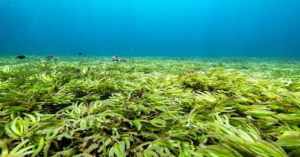Physical Address
23,24,25 & 26, 2nd Floor, Software Technology Park India, Opp: Garware Stadium,MIDC, Chikalthana, Aurangabad, Maharashtra – 431001 India
Physical Address
23,24,25 & 26, 2nd Floor, Software Technology Park India, Opp: Garware Stadium,MIDC, Chikalthana, Aurangabad, Maharashtra – 431001 India

The inaugural World Seagrass Day was celebrated on March 1, 2023, following the United Nations General Assembly’s decision in 2022 to annually commemorate this significant occasion.
Sea grasses, locally known as ‘Muhudu thruna’ in Sinhala and ‘Wattawa’ in Tamil, resemble terrestrial grass and thrive in shallow waters worldwide, from the tropics to the Arctic Circle, playing a crucial role in coastal ecosystems.
Biodiversity and Distribution
While Sri Lanka is rich in sea grass diversity, the full composition and distribution along its coast remain uncertain.
According to Susantha Udagedara of the Blue Resources Trust, Sri Lanka boasts 15 out of the 72 sea grass species globally. The estimated 37,137 hectares of sea grass meadows in Sri Lanka are concentrated in areas such as Negombo, Mannar, Jaffna, Batticaloa, Puttalam, Chilaw, Trincomalee, Polhena, Weligama, and Nilawella. However, the distribution of sea grasses along the coast from north-east to south-east is limited, and no records are available. No type of sea grass is endemic to Sri Lanka because its seeds are carried by ocean currents.

Pic courtesy :Malaka Rodrigo
Ongoing research led by Udagedara, spanning over 11 years, highlights the need for further exploration and identification of seagrass species to enhance conservation efforts.
Ecological Role and Climate Change Mitigation
Sea grasses serve as marine flowering plants, contributing significantly to the marine environment. Acting as vital nurseries and habitats, they provide shelter and sustenance for numerous fish and marine organisms. Beyond their ecological importance, sea grasses absorb pollutants and nutrients, functioning as effective carbon sinks and mitigating climate change impacts.
Sea grasses, along with mangroves and tidal marshes, form important ecosystems in coastal wetlands. These areas, known as blue carbon ecosystems, play a crucial role in capturing and storing carbon. Blue carbon refers to the carbon sequestered in living and nonliving biomass, as well as the soil of mangroves, tidal marshes, and sea grass meadows. The soil in these ecosystems, which is saturated with water and low in oxygen, allows for significant carbon accumulation over time.
Sea grasses, part of the blue carbon ecosystems, are essential for carbon sequestration. While they store carbon in their living biomass for the short term, the soil in these ecosystems retains carbon for much longer periods. Recent studies indicate that mangroves, another component of blue carbon ecosystems, globally capture about 24 teragrams of carbon annually, accumulating approximately 6.5 petagrams of carbon, and acting as nature’s defense against climate change impacts.

Pic courtesy: Ocean & Coastal Management
Threats and Conservation Efforts
Globally, nearly 30% of sea grass meadows have already been lost, with an alarming rate of 110 square kilometers disappearing annually.
Among the sea grass species present in Sri Lanka, one is considered at risk and labeled as “Endangered,” six are categorized as “Near Threatened,” and two are deemed “Least Concerned” according to the 2012 National Red List.
Sri Lanka faces threats such as industrial and agricultural runoff, coastal development, unregulated fishing, aquaculture, and tourism activities that harm sea grasses. The nation, having proposed Seagrass Day, demonstrates a commitment to conservation.
Dr. Anil Jasinghe, the Secretary of the Environment Ministry, emphasizes the need for serious conservation efforts, given that seagrasses cover only 0.1% of the world’s ocean floor yet store up to 18% of the world’s oceanic carbon. With approximately 9 billion metric tons of carbon stored globally in seagrass meadows, their destruction could contribute to rising global warming.
Sea grass research in Sri Lanka
Research on sea grasses in Sri Lanka started in the 1860s, and recent efforts have been dedicated to studying species diversity, distribution, and environmental functions. Challenges, including anthropogenic activities and a lack of comprehensive studies, persist. The Northern, North-Western, and North-Eastern coasts, where sea grass meadows thrive, face research gaps due to past conflicts.
Conservation policies and knowledge gaps
Sri Lanka has enacted policies, such as “The National Policy on Conservation and Sustainable Utilization of Mangrove Ecosystems,” demonstrating a commitment to protecting coastal wetlands. However, challenges persist, including the degradation of mangrove areas at a rate of 20.17 hectares per year. A lack of monitoring and awareness among communities contributes to ecosystem degradation.
The country has signed international conventions like the Convention on Biological Diversity (CBD) and the United Nations Framework Convention on Climate Change (UNFCCC), aligning with global efforts. However, knowledge gaps persist in quantifying blue carbon stocks in tidal marshes and seagrass meadows. Comprehensive research is essential to assess the impacts of climate change, ecosystem services, and the socio-economic importance of these ecosystems.
Therefore, conservation efforts must focus on sustainable practices, community awareness, and comprehensive research to address existing knowledge gaps. By safeguarding seagrass ecosystems, Sri Lanka contributes to the global fight against climate change, protecting the invaluable services these habitats provide. As the world celebrates Seagrass Day, it serves as a reminder of the urgent need to preserve these underwater meadows for the well-being of our oceans and the planet.
-With inputs from G. R. Diwyanjalee –